5 June 2005
Enroute to Panama From the East End of Cuba to Panama
Life After the Windward Passage
Well, we continue to make progress toward our destination.
We planned this passage for an average of 6 knots of boat speed and in retrospect that was too ambitious. We are now sailing against the Gulf Stream current and the winds this time of year are very unpredictable. At dawn and dusk, the winds die down but today at midday we are still luffing along with only 6 knots of wind and making only 2.5 knots of boat speed. We have about six days remaining in the trip and about four days of fuel, so we use the engines judiciously. With several months supply of food and drinks on board it is just a matter of being patient, waiting on weather. Our watermaker runs on AC from the generator which also consumes our diesel supply and we take that into consideration since we want to continue to shower every day. What wind there has been during the last few days has been on the nose and our COG (course over ground) on the chart plotter which tracks our progress looks like the teeth of a saw. We tack and tack and tack and sail five miles for every mile of "east" we make.
The weather forecast indicates we should soon have 15 or more knots of wind during the remainder of the trip. Every day we request wind and wave charts from our provider of e-mail, Winlink. These charts come from the National Weather Service and are transmitted to our single sideband radio, received in our computer and then we print them. They have proven to be very accurate. Below are some samples of our downloaded weather fax for you to decipher. The charts cover tomorrow and the two days following. We also monitor several weather forecast on the single sideband radio.
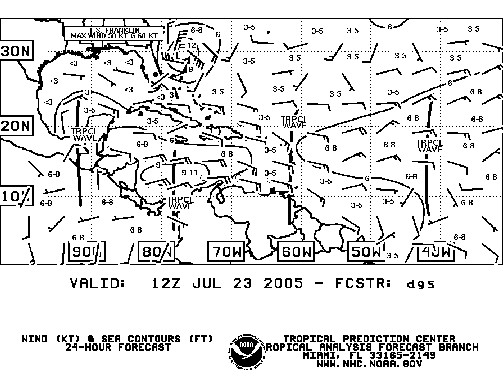
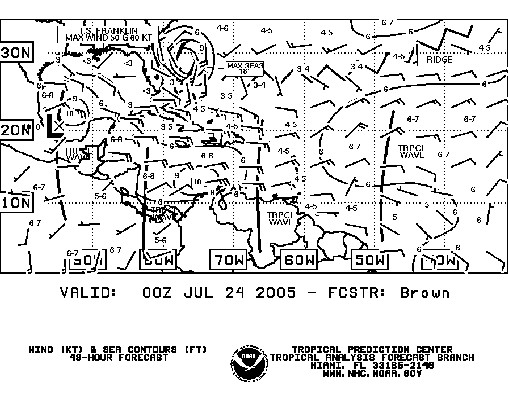
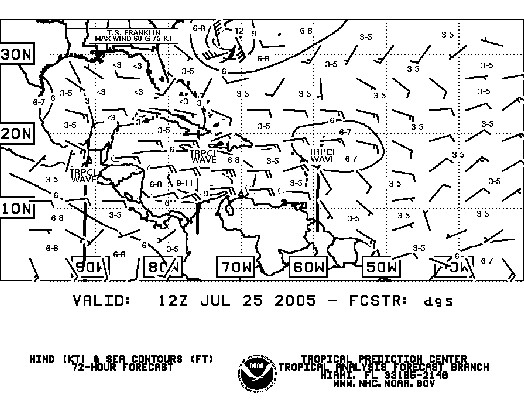
Be Careful What You Wish For
Last night after sitting becalmed for four hours, the wind picked up suddenly blowing 25-30 knots. An increase in the wind means an increase in waves and soon they were averaging 8 feet or more. It was the proverbial "calm before the storm" that we had been experiencing with a low in the area drawing all the air out before moving through. But what happened to the 15 knots we had seen on the charts? The wind-wave charts show the pattern changing every day and from one download to the next, the same day could be considerably different. If you were to look at a forecast for June 02 at 1800 Zulu at 24 hours out, then 36 hours, then 72 hours, you could see how unstable weather can be even during this time of year. An average of three tropical waves are present in the Caribbean any given day starting around June and eventually some turn into tropical storms and some even evolve into hurricanes.
But anyway, now we are moving albeit bouncy and uncomfortable. Our primary consideration is not how we are taking the weather but how is our autopilot taking the weather? That question was answered early on the morning of the 2nd of June when we hove-to since the autopilot couldn't hold the course. This is not that unusual and if you hand steer in these conditions you understand there is a great deal of force required to hold the wheel in the correct position in quartering seas. This is why you see those oversized wheels on racing boats. The next morning the winds were consistently below 30 knots and we headed back into the breech with two reefs and renewed determination. The waves are still above 8 feet and the boat is pitching and yawling. Occasionally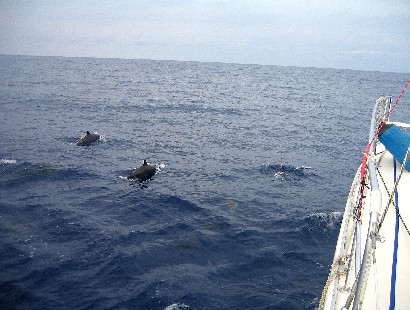 the NE swell would bring in a 12 to 15 footer making it feel like a carnival ride. Spinner dolphin seemed to enjoy the crashing waves. They join us for a short ride and jumped from waves breaking above the foredeck completely out of the water in front of the bow. With that omen we know everything was going well. The picture to the right is one taken of the spinners in calmer weather. We don't chance getting our digital camera doused with salt water. the NE swell would bring in a 12 to 15 footer making it feel like a carnival ride. Spinner dolphin seemed to enjoy the crashing waves. They join us for a short ride and jumped from waves breaking above the foredeck completely out of the water in front of the bow. With that omen we know everything was going well. The picture to the right is one taken of the spinners in calmer weather. We don't chance getting our digital camera doused with salt water.
We are making 9 knots steady. Our weatherman tells us that conditions will improve in the next 12 hours but for now it is like being in a washing machine. We spend most of the time in the cabin since the helm station and cockpit are often awash. Even the "in cabin" activities are held to a minimum since moving about is a balancing act requiring good handholds. Every 15 minutes we go to the cockpit and scan the horizon looking for traffic. This act is often accompanied by a saltwater face wash. After heading south of Jamaica we have seen little traffic and on some shifts we see none but that doesn't lessen our diligence.
In the Zone
Conditions have calmed a bit and we are now making around 7 knots and eating up the mileage in much more comfortable conditions. Nothing placid but more comfortable. This is the part of the trip we hadn't planned for as well as we should have since gin rummy is interesting for only about an hour at a stretch and there are no interesting book titles onboard.
Out of the Zone
There are two exciting ways to watch a lighting storm. One is standing under a tree with your golf clubs and old metal spikes on, smoking what could 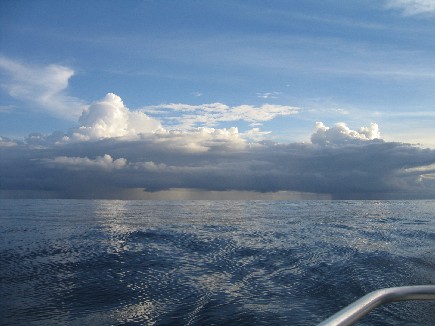 be your last cigarette. And the other is to be at sea sitting under the only 55 foot lighting rod within 100 miles. The difference is that one requires a burial and the other only a memorial service. be your last cigarette. And the other is to be at sea sitting under the only 55 foot lighting rod within 100 miles. The difference is that one requires a burial and the other only a memorial service.
Owners of small plastic boats have two philosophies about lighting. The first is to have every possible metal device onboard grounded to all other metal devices including a grounding plate and then to the metal thru-hulls in the boat. The intent is to channel a lightening strike through all your electrical equipment burning it to a crisp and sending the charge overboard after it has done $100,000.00 in damage. The second is for the lighting to find its own way out of the boat usually leaving a two foot hole in the hull. Shiraz ascribes to the first theory although it is only a theory. Many boat owners think you are only fooling yourself if you think lighting will travel in a path you have laid out. We prefer not to test the theory this evening but we do have lightning in every quadrant of the compass and the winds are light and very variable, so much so that we are motoring.
Bocas Marina N 09.20.156 W 082.14.772
Fourteen days after departing Riviera Beach Marina we have arrived. The entrance to Bocas is well marked with lighted buoys and channel separators. This is a large boat channel for the banana boat taking on cargo from the local plantations The markers begin at approximately N 09 22.02 W 82 12.5. We turned toward the town at N 09 19.9 W82 13.74 and headed to waypoint N09 20.094 W82 14.504. Boats with a four foot draft or more need to stay close to the town buildings until the last yellow building pictured below from which you can head directly for the marina You will also see an anchorage behind the marina in Saigon Bay Go in with good light and watch for coral heads.
We are docked at Bocas Marina in Bocas del Toro, Panama and are negotiating a rate to leave the boat for our trip back to the US and we are still working our way through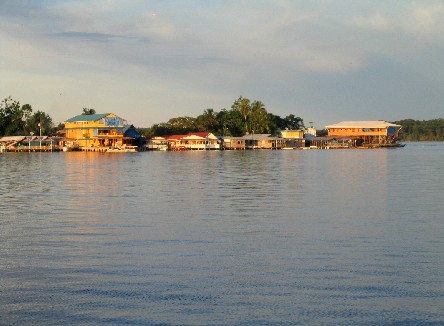 customs and immigration. It all started when we checked into the US and went to Border Protection to clear immigration after we cleared customs by telephone. While at the Riviera Beach facility we thought it prudent to check about clearance procedures since port regulations have changed under the Department of Homeland Security. We checked and there would be no need to check out of the US. If you think about it this is reasonable since the US is your national registry. On our first trip out of the US we didn't even stop to consider if we needed to check out. That trip was over two years ago and our first landing was in the Bahamas where they check in over 20,000 US flagged vessels visit each year. The traffic is much higher then that since a check in is good for one year. Well, we took the word of the US Customs and Boarder Protection official but it appears that the word had not yet hit Panama. But there probably hasn't been a boat that has traveled directly from the US to Bocas in years and years, if ever. We were able to call US Border Protection and get a fabricated copy faxed to us. customs and immigration. It all started when we checked into the US and went to Border Protection to clear immigration after we cleared customs by telephone. While at the Riviera Beach facility we thought it prudent to check about clearance procedures since port regulations have changed under the Department of Homeland Security. We checked and there would be no need to check out of the US. If you think about it this is reasonable since the US is your national registry. On our first trip out of the US we didn't even stop to consider if we needed to check out. That trip was over two years ago and our first landing was in the Bahamas where they check in over 20,000 US flagged vessels visit each year. The traffic is much higher then that since a check in is good for one year. Well, we took the word of the US Customs and Boarder Protection official but it appears that the word had not yet hit Panama. But there probably hasn't been a boat that has traveled directly from the US to Bocas in years and years, if ever. We were able to call US Border Protection and get a fabricated copy faxed to us.
This complicated our arrival especially in an area where "the bite" still prevails. This system of bribes is approached with unmitigated gull. We arrived at 11:00 AM and the Port Captain arranged to meet us at 1:30 PM. 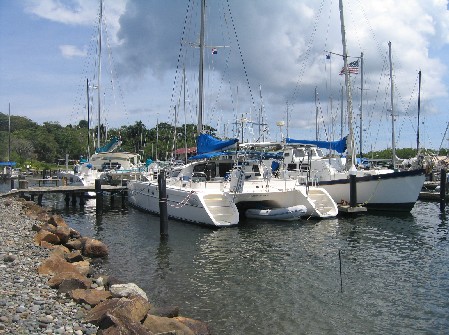 At 6:00 PM he showed up with a customs officer and demanded a $20.00 overtime charge. This didn't set well with us since we had been waiting for them and not leaving the boat since before noon. And we let them know how we felt. We were tired and ready to relax with a 14 day, not so good weather, sail behind us. Next morning the immigration officer, an irascible character, ask if we were going to take care of him, we nodded. After completing the forms and a walk through the town being introduced to everyone the officer knew, we finally completed the process. When we gave him $10.00 he looked questioningly to us and said "You don't have $20?". Because of the scene we had caused the evening before and knowing that we had to get checked in to this country before we could leave for the US, we gave him another $10. At this writing we have not yet received our cruising permit and we are due to leave for the US in 10 days. This will no doubt take another "tip". Throughout all of our travels we have not yet been asked by any official for a bribe, in any country except Panama. This tells you something about Bocas and the local political situation. With the recent change in national political leadership in Panama, local bureaucrats have also changed and they are learning how or how not to supplement their income. At 6:00 PM he showed up with a customs officer and demanded a $20.00 overtime charge. This didn't set well with us since we had been waiting for them and not leaving the boat since before noon. And we let them know how we felt. We were tired and ready to relax with a 14 day, not so good weather, sail behind us. Next morning the immigration officer, an irascible character, ask if we were going to take care of him, we nodded. After completing the forms and a walk through the town being introduced to everyone the officer knew, we finally completed the process. When we gave him $10.00 he looked questioningly to us and said "You don't have $20?". Because of the scene we had caused the evening before and knowing that we had to get checked in to this country before we could leave for the US, we gave him another $10. At this writing we have not yet received our cruising permit and we are due to leave for the US in 10 days. This will no doubt take another "tip". Throughout all of our travels we have not yet been asked by any official for a bribe, in any country except Panama. This tells you something about Bocas and the local political situation. With the recent change in national political leadership in Panama, local bureaucrats have also changed and they are learning how or how not to supplement their income.
The marina is located a short dinghy ride from the town. Bocas del Toro is a struggling tourist destination for surfers, trekkers and people who received bad information from their travel agent. This is the low season because of the heat but even in the high season you can tell things are not booming. The town cries out for infrastructure. It is in need of roads, government buildings, 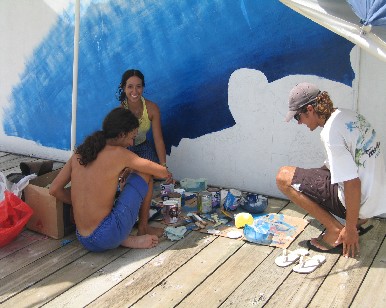 sidewalks, utilities, water and promotion. The marina however is relative new and at this time of year is utilized as a place to store your boat during hurricane season. There are floating docks and the place is kept in a good state of repair. The draw back is that it is very hot and humid during this part of the year and electricity here at the marina is very expensive. If we ran our air conditioning all day it would cost as much as the dock space. So we turn the AC on at dusk when the no-see-ums come out and close everything up and turn it off sometime in the middle of the night. There are about eighty slips in the marina with about half that many boats but only ten boats have live-aboards and all of them we know are leaving for the states or an extended visit to South America or anyplace just to escape the heat and the insects. sidewalks, utilities, water and promotion. The marina however is relative new and at this time of year is utilized as a place to store your boat during hurricane season. There are floating docks and the place is kept in a good state of repair. The draw back is that it is very hot and humid during this part of the year and electricity here at the marina is very expensive. If we ran our air conditioning all day it would cost as much as the dock space. So we turn the AC on at dusk when the no-see-ums come out and close everything up and turn it off sometime in the middle of the night. There are about eighty slips in the marina with about half that many boats but only ten boats have live-aboards and all of them we know are leaving for the states or an extended visit to South America or anyplace just to escape the heat and the insects.
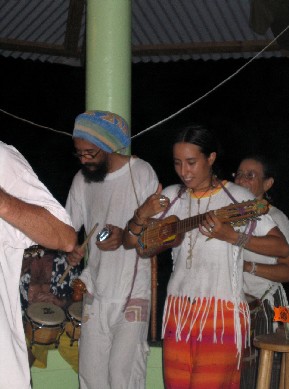
But like good cruisers everywhere on Friday night there is a pot luck dinner. On the Friday night before we left there was live entertainment at the potluck. A family that has been traveling Central and South America on tandem bikes for five years played and sang for us. They make their living as a musical troupe and supplement that income (tips) by painting murals. The son and daughter are being paid to turn the fuel dock wall into a piece of art. It will be finished when we return from our trip to the US and we will show you the completed project in our next log. To enjoy the show everyone slathered up with their favorite DEET product and turned on a fogger to drive away the mosquitoes and no-see-ums. No doubt, inhaling all this smoke left some cruisers twitching the next morning.
Back Next
|